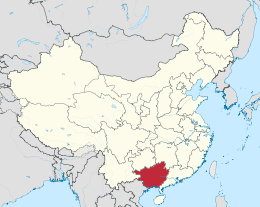ই ভাষা: সংশোধিত সংস্করণের মধ্যে পার্থক্য
{{কাজ চলছে}} |
(কোনও পার্থক্য নেই)
|
০৮:৫৩, ১ জানুয়ারি ২০১৬ তারিখে সংশোধিত সংস্করণ
এই নিবন্ধ বা অনুচ্ছেদটি পরিবর্ধন বা বড় কোনো পুনর্গঠনের মধ্যে রয়েছে। এটির উন্নয়নের জন্য আপনার যে কোনো প্রকার সহায়তাকে স্বাগত জানানো হচ্ছে। যদি এই নিবন্ধ বা অনুচ্ছেদটি কয়েকদিনের জন্য সম্পাদনা করা না হয়, তাহলে অনুগ্রহপূর্বক এই টেমপ্লেটটি সরিয়ে ফেলুন। ৮ বছর আগে বলরাম (আলাপ | অবদান) এই নিবন্ধটি সর্বশেষ সম্পাদনা করেছেন। (হালনাগাদ) |
ই (সরলীকৃত চীনা: 诶话; প্রথাগত চীনা: 誒話; ফিনিন: Ē Huà) or ইউসি/ইউসিহুয়া (সরলীকৃত চীনা: 五色话; প্রথাগত চীনা: 五色話; ফিনিন: Wŭsè Huà; আক্ষরিক: "Colored Language") হয় একটি তাই–চাইনিজ সংমিশ্রিত ভাষা যা প্রাথমিকভাবে রঙ্গুসুই মিওয়াউ অটোনোমাস দেশে, গুয়ানঞ্জিক্সি, চীনে বলা হয় । এটি তাই ব্যাকরণ হতে চাইনিজ শব্দভাণ্ডার বাদ দিয়ে ,তাই ও চাইনিজ উভয় ভাষার শব্দ বৈশিষ্ট্য বহন করে। ই হয় একটি স্বরীয় ভাষা— যা সপ্ত tones স্বরের মধ্যে পার্থক্য নির্দেশ করে — এবং কিছু বিরল উচ্চারণ ধারন করে যেমন : সাধারন আলজিহবার কাছাকাছি পার্শ্বদেশীয় এবং নাসারন্ধ্রীয় ব্যঞ্জনবর্ণ গুলোর স্বরহীন ভার্শন।
| E | |
|---|---|
| Wuse | |
| Kjang E | |
| অঞ্চল | Guangxi, China |
মাতৃভাষী | (1992 অনুযায়ী 30,000)[১] |
| ভাষা কোডসমূহ | |
| আইএসও ৬৩৯-৩ | eee |
| গ্লোটোলগ | eeee1240[২] |
 Guangxi, of which E is spoken in a small area | |
শব্দ তত্ত্ব
ই ভাষার অব্যবহৃত পিনিন- যা একটি অস্বচ্ছ নাম, যা একটি স্বয়ংক্রিয় শব্দ, যা একটি বর্ণ ই দিয়ে গঠিত হয়।[৩]এই প্রতিরূপটি Simplified Chineseসরলীকৃত চাইনিজের "诶" এবং ঐতিহ্যবাহী চাইনিজের "誒" ভাষায় লিখা, যা স্বীকৃতিসরূপ ভাব হিসেবে বোঝায়।[৪] ভাষাবক্তারা তাদের ভাষাকে "কেজাং ই" রুপেও নির্দেশ করে.[৩] ইউসিহুয়া ই ভাষার জন্য একটি মর্যাদা হানিকর নাম।[৫]
Geographical distribution
In 1992, E was spoken by about 30,000 people,[৩] but by 2008 this number had dwindled to 9,000.[৬] Most E speakers are classified as Zhuang by the Chinese government. E speakers live primarily in the Guangxi autonomous region of China, specifically in the Rongshui Miao county and border areas of Luocheng Mulao. Villages inhabited by E speakers include Xiatan, Simo, Xinglong, and the Yonglei district. Ethnologue classifies E as rank 6b (Threatened). E speakers' most commonly spoken other languages are Yue Chinese and the Guiliu variant of Southwestern Mandarin.[৭]
Phonology
E's consonant and vowel inventories are mostly similar to those of its parent languages. However, it contains a few unusual consonants: the voiceless nasal consonants [n̥], [ŋ̥], [m̥], and the voiceless alveolar lateral approximant [l̥]. All are voiceless versions of consonants that, in most languages, are always voiced. E allows syllabic consonants and diphthongs.[৬]
|
| ||||||||||||||||||||||||||||||||||||||||||||||||||||||||||||||||||||||||||||||||||||
Like most Southeast Asian languages, including Tai and the varieties of Chinese, E is tonal.[৮] The language is described as having seven tones, with the seventh varying allophonically with the length of the vowel it is attached to. With numbers ranging from 1 to 5, with 1 being the lowest tone and 5 the highest, the contours of the various tones in E are as follows.[৬]
| Number | Contour | Tone letter | |
|---|---|---|---|
| 1. | 42 | ˦˨ | |
| 2. | 231 | ˨˧˩ | |
| 3. | 44 | ˦ | |
| 4. | 35 | ˧˥ | |
| 5. | 24 | ˨˦ | |
| 6. | 55 | ˥ | |
| 7. | Short | 24 | ˨˦ |
| Long | 22 | ˨ | |
Grammar and lexicon
E is usually classified as a mixed language deriving ultimately from the Tai-Kadai and Sino-Tibetan families, which both inhabit southern China and Southeast Asia.[৫] Some non-Chinese scholars, however, consider it a Tai-Kadai language with Chinese influence.[৯] Whatever its classification, the grammar resembles that of the Tai branch of Tai-Kadai. Specifically, scholars consider E's grammatical features a blend of Northern Zhuang, Mulam, and Kam.[৭][৮] The Caolan language of Vietnam displays many similarities with E.[৮]
The vocabulary, however, is mostly Chinese, based on Guiliu and the Tuguai variant of Pinghua.[৭][৮] Out of the 2,000 most commonly used E words, only about 200 are of Tai-Kadai origin.[১০] E also inherits elements of these Chinese dialects' phonology and compound word formation.[৭] E morphology is primarily analytic, with concepts such as negation expressed with auxiliary words (pat6, m2) and no pronominal agreement.[৬]
In its pronouns, E distinguishes for person between first, second, and third; in number between singular and plural; and, in the case of the second-person plural, between inclusive and exclusive we. E does not, however, make distinctions for grammatical gender.[৬]
|
|
|
Notes
- ↑ এথ্নোলগে E (১৮তম সংস্করণ, ২০১৫)
- ↑ হ্যামারস্ট্রোম, হারাল্ড; ফোরকেল, রবার্ট; হাস্পেলম্যাথ, মার্টিন, সম্পাদকগণ (২০১৭)। "E"। গ্লোটোলগ ৩.০ (ইংরেজি ভাষায়)। জেনা, জার্মানি: মানব ইতিহাস বিজ্ঞানের জন্য ম্যাক্স প্লাংক ইনস্টিটিউট।
- ↑ ক খ গ Edmondson 1992, পৃ. 138।
- ↑ Unihan Database 1991।
- ↑ ক খ Encyclopedia of Linguistics 2003, পৃ. 207।
- ↑ ক খ গ ঘ ঙ Greenhill, Blust এবং Gray 2008।
- ↑ ক খ গ ঘ Lewis, Simons এবং Fennig 2014।
- ↑ ক খ গ ঘ Edmondson 1992, পৃ. 135–144।
- ↑ Moseley 2012, পৃ. 72।
- ↑ Meizhin 2007, পৃ. 2596–2620।
References
- Edmondson, Jerold A. (১৯৯২)। The language game: papers in memory of Donald C. Laycock। Canberra: Australian National University।
- Greenhill, S.J.; Blust, R.; Gray, R.D. (২০০৮)। "The Austronesian Basic Vocabulary Database: From Bioinformatics to Lexomics – Language: Wusehua (Rongshui)"। University of Auckland। সংগ্রহের তারিখ ডিসেম্বর ৩, ২০১৪।
- Lewis, M. Paul; Simons, Gary F.; Fennig, Charles D. (২০১৪)। "Ethnologue: Languages of the World, Seventeenth edition – E"। SIL International। সংগ্রহের তারিখ ডিসেম্বর ৩, ২০১৪।
- Meizhin, Luo (২০০৭)। 中国的语言 (Chinese ভাষায়)। Commercial Press।
- Moseley, Christopher (২০১২)। Atlas of the World's Languages in Danger। UNESCO Publishing। আইএসবিএন 978-0-956-60524-5।
- International Encyclopedia of Linguistics: AAVE–Esperanto। 1। Oxford University Press। আইএসবিএন 978-0-195-16783-2।
- "Unihan data for U+8A92"। Unicode.org। সংগ্রহের তারিখ নভেম্বর ২৩, ২০১৪।
- Wei Maofan [韦茂繁] (2011). A study of Wusehua [五色话研]. Beijing: Minzu University Press. ISBN 9787105113651